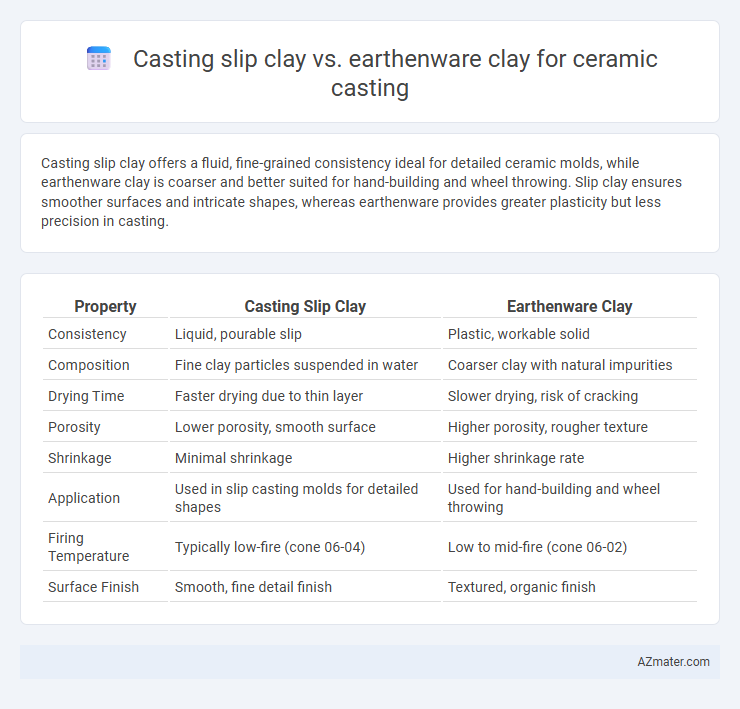Casting slip clay offers a fluid, fine-grained consistency ideal for detailed ceramic molds, while earthenware clay is coarser and better suited for hand-building and wheel throwing. Slip clay ensures smoother surfaces and intricate shapes, whereas earthenware provides greater plasticity but less precision in casting.
Table of Comparison
| Property | Casting Slip Clay | Earthenware Clay |
|---|---|---|
| Consistency | Liquid, pourable slip | Plastic, workable solid |
| Composition | Fine clay particles suspended in water | Coarser clay with natural impurities |
| Drying Time | Faster drying due to thin layer | Slower drying, risk of cracking |
| Porosity | Lower porosity, smooth surface | Higher porosity, rougher texture |
| Shrinkage | Minimal shrinkage | Higher shrinkage rate |
| Application | Used in slip casting molds for detailed shapes | Used for hand-building and wheel throwing |
| Firing Temperature | Typically low-fire (cone 06-04) | Low to mid-fire (cone 06-02) |
| Surface Finish | Smooth, fine detail finish | Textured, organic finish |
Introduction to Ceramic Casting Clays
Casting slip clay consists of fine particles suspended in water, offering excellent fluidity and detail replication ideal for ceramic mold casting. Earthenware clay, while coarser and less fluid, has higher plasticity suitable for hand-building but requires significant modification for successful slip casting. Both clays serve specific purposes in ceramic casting, with casting slip clay preferred for intricate shapes and earthenware clay favored for more robust, traditional pottery forms.
What is Casting Slip Clay?
Casting slip clay is a liquid mixture of fine clay particles suspended in water, specifically formulated for ceramic slip casting processes where the slip is poured into plaster molds to create detailed and uniform shapes. Earthenware clay typically has coarser particles and impurities, making it less suitable for slip casting due to its slower drying time and lower plasticity compared to the smooth texture and fine particle size of casting slip clay, which ensures better mold release and surface finish. The high water content and precise particle size distribution in casting slip clay improve its flow characteristics, allowing for more controlled wall thickness in ceramic production.
Understanding Earthenware Clay
Earthenware clay, characterized by its porous and low-fire properties, offers distinct advantages for ceramic casting due to its plasticity and ease of shaping. Unlike casting slip clay, earthenware requires careful moisture control to prevent cracking and shrinkage during drying and firing, providing a more tactile experience for artisans. Its ability to absorb water makes it ideal for functional wares but necessitates glazing for durability and vitrification.
Key Differences: Slip Clay vs Earthenware Clay
Casting slip clay is a liquid, finely ground clay mixture designed for ceramic slip casting, offering smooth flow for detailed mold filling. Earthenware clay is a coarser, solid clay body that requires hand molding or wheel throwing, known for its lower firing temperature and porous final product after firing. The key differences center on slip clay's fluid properties enabling precise mold replication versus earthenware's malleable, less refined texture suited for traditional shaping and lower-temperature kiln firings.
Material Composition and Properties
Casting slip clay consists of finely ground, deflocculated particles suspended in water, producing a fluid, adjustable consistency ideal for detailed ceramic molding through slip casting. Earthenware clay contains larger, coarser particles with higher feldspar and iron oxide content, resulting in a porous, less vitrified material after firing that suits hand-building or wheel-throwing methods. The low plasticity and high fluidity of casting slip optimize mold filling and surface detail, while earthenware's coarse texture and firing properties limit its use in precise slip casting processes.
Preparation and Handling Techniques
Casting slip clay requires thorough sieving and deflocculation to ensure smooth, pourable consistency essential for ceramic casting molds, whereas earthenware clay demands more extensive wedging to achieve plasticity before slip preparation. Slip clay is typically mixed with a specific water-to-clay ratio and additives like deflocculants to reduce drying time and improve mold release, while earthenware clay needs careful moisture control to prevent cracking during drying. Handling slip clay involves continuous agitation to maintain homogeneity, contrasting with earthenware clay's bulk manipulation techniques focused on uniform texture and minimal air bubbles.
Firing Temperatures and Results
Casting slip clay typically requires a firing temperature between 1,060degC and 1,150degC, resulting in a more porous and slightly weaker ceramic body ideal for detailed molds and thin-walled pieces. Earthenware clay fires at a lower range of 1,000degC to 1,150degC, producing a more porous and less vitrified surface that is often glazed to enhance durability and water resistance. The higher firing temperature of casting slip clay achieves better strength and detail retention compared to the more rustic and porous finish of earthenware clay.
Advantages of Casting Slip Clay
Casting slip clay offers superior fluidity compared to earthenware clay, enabling precise and detailed mold filling that reduces air bubbles and surface imperfections. Its fine particle suspension enhances smoothness and consistency, resulting in thinner, more uniform walls ideal for delicate ceramic pieces. This clay type also accelerates drying and firing times, improving production efficiency while maintaining structural integrity.
Benefits of Using Earthenware Clay
Earthenware clay offers enhanced plasticity and easier manipulation compared to casting slip clay, making it ideal for hand-building and wheel-throwing techniques. Its natural porous structure allows for better moisture absorption, which improves the drying process and reduces cracking risks during firing. Additionally, earthenware clay's rich iron content provides warm, earthy tones and a more durable final product suitable for functional ceramics.
Choosing the Right Clay for Your Ceramic Projects
Casting slip clay offers a smooth, fluid consistency ideal for detailed ceramic molds and producing thin, lightweight pieces, while earthenware clay is denser and better suited for hand-building or wheel-throwing projects requiring robust, durable forms. Selecting the right clay depends on the project's desired texture, finish, and structural requirements, with casting slip providing precision and earthenware delivering strength. Understanding the specific properties of each clay type ensures optimal results for functional or decorative ceramics.

Infographic: Casting slip clay vs Earthenware clay for Ceramic casting
 azmater.com
azmater.com